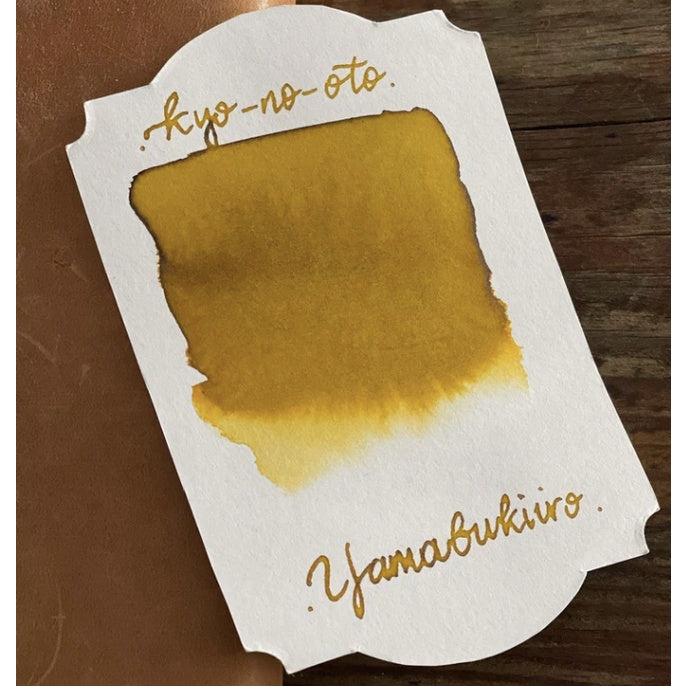1
/
of
10
The Hobby Shoppe Philippines
TAG Kyoto KYO NO OTO Fountain Pen Ink Sample (3mL)
TAG Kyoto KYO NO OTO Fountain Pen Ink Sample (3mL)
No reviews
Regular price
₱140.00 PHP
Regular price
₱140.00 PHP
Sale price
₱140.00 PHP
Quantity
Couldn't load pickup availability
KYO NO OTO Ink Sample in 3ml vial with o-ring to prevents spillage.
Made in Kyoto, Japan
KYO NO OTO fountain pen inks are made in Kyoto, Japan. They are crafted according traditional Japanese dyeing techniques. These colors are Japanese traditional colors that has been used since Heian era (roughly 1000 years ago), which are the expression of its history and profound culture for a long time.
Kokeiro – The olive-green ink’s name is inspired by old mossy trees and stones that can often be found in Kyoto’s beautiful gardens. It is a symbol of the Wabi-Sabi aesthetics that permeates Japanese culture.
Yamabukiiro – This ink is named after the Yamabuki flower (“Mountain Breath”), that is found in abundance on Japanese mountainsides. The yellow-amber colour grabs your attention, not because it is bright and bold – au contraire – but because it is tender and soft, harmonious and elegant, and with a surprising depth of character.
Hisoku – translates to “secret colour”. It is named after the mysterious beauty of the ash-coloured blue-green unique to Celadon pottery (also known as greenware).
Sakuramezumi - The ink's name derives from a type of pigment (iron-holding Magnesium-Aluminum-Silicate) that is traditionally used in Japanese painting techniques. The name literally translates to "Cherry Blossom Mouse" and refers to the purple and grey character of the colour. Sakuranezumi is a dusty grey-purple that fits an ancient Japanese setting.
Ochiguriiro - a color of chestnut and coal-brown. Ochiguri means a fallen chestnut on the ground. This brown is a blackish coal like color first, and it turns into a tannish chestnut brown after shading. In Tale of Genji, a classic literature of Japan which is written in Heian period (11th century), it is described as a popular brown color used for ladies' kimono.
Ryokujuiro - a beautiful muted green with strong blue undertones. The ink’s name is derived from the ryokuyu glaze, which produces a green colour in pottery. It is one of the oldest glazes and was already used in China in BC. In Japan, it has been produced since the Heian period and has been favoured by many aristocrats.
Keshimurasaki – A deep cool grey limited edition. This ink is supposedly inspired by the formal kimono dresses during the Heian era, when Kyoto was the capital of Japan. 'Keshi' means 'off' and 'murasaki' means 'purple' - this quite accurately describes the blue-purple-grey colour of this ink. This definitely is my type of ink: an unsaturated soft pastel-type colour, shadowy and smoky, with an elegant complexity.
Ginkaisyoku - a limited edition subtle blue-grey verdigris-type ink with a silvery-blue shimmer. The ink’s name reflects the colour of thin clouds, as referred to in the waka poem that Genji composed.
3mL ink samples contained in a plastic vial with an o-ring to ensure a proper seal.
Made in Kyoto, Japan
KYO NO OTO fountain pen inks are made in Kyoto, Japan. They are crafted according traditional Japanese dyeing techniques. These colors are Japanese traditional colors that has been used since Heian era (roughly 1000 years ago), which are the expression of its history and profound culture for a long time.
Kokeiro – The olive-green ink’s name is inspired by old mossy trees and stones that can often be found in Kyoto’s beautiful gardens. It is a symbol of the Wabi-Sabi aesthetics that permeates Japanese culture.
Yamabukiiro – This ink is named after the Yamabuki flower (“Mountain Breath”), that is found in abundance on Japanese mountainsides. The yellow-amber colour grabs your attention, not because it is bright and bold – au contraire – but because it is tender and soft, harmonious and elegant, and with a surprising depth of character.
Hisoku – translates to “secret colour”. It is named after the mysterious beauty of the ash-coloured blue-green unique to Celadon pottery (also known as greenware).
Sakuramezumi - The ink's name derives from a type of pigment (iron-holding Magnesium-Aluminum-Silicate) that is traditionally used in Japanese painting techniques. The name literally translates to "Cherry Blossom Mouse" and refers to the purple and grey character of the colour. Sakuranezumi is a dusty grey-purple that fits an ancient Japanese setting.
Ochiguriiro - a color of chestnut and coal-brown. Ochiguri means a fallen chestnut on the ground. This brown is a blackish coal like color first, and it turns into a tannish chestnut brown after shading. In Tale of Genji, a classic literature of Japan which is written in Heian period (11th century), it is described as a popular brown color used for ladies' kimono.
Ryokujuiro - a beautiful muted green with strong blue undertones. The ink’s name is derived from the ryokuyu glaze, which produces a green colour in pottery. It is one of the oldest glazes and was already used in China in BC. In Japan, it has been produced since the Heian period and has been favoured by many aristocrats.
Keshimurasaki – A deep cool grey limited edition. This ink is supposedly inspired by the formal kimono dresses during the Heian era, when Kyoto was the capital of Japan. 'Keshi' means 'off' and 'murasaki' means 'purple' - this quite accurately describes the blue-purple-grey colour of this ink. This definitely is my type of ink: an unsaturated soft pastel-type colour, shadowy and smoky, with an elegant complexity.
Ginkaisyoku - a limited edition subtle blue-grey verdigris-type ink with a silvery-blue shimmer. The ink’s name reflects the colour of thin clouds, as referred to in the waka poem that Genji composed.
3mL ink samples contained in a plastic vial with an o-ring to ensure a proper seal.
Share

































